February 4.
After breakfast at the hotel, we drive approximately two hours to Guatapé, stopping en route for coffee, sausages, etc at roadside restaurant.
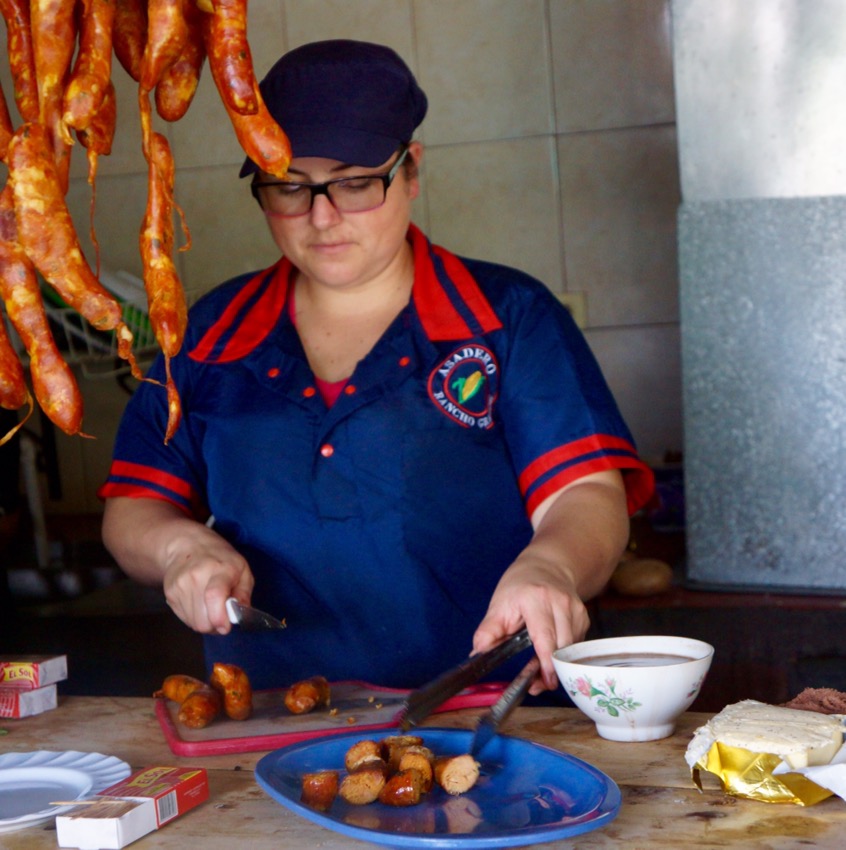
Guatapé is a picturesque lake town with zócalos, colorful designs of friezes on the lower parts of houses, and cobblestone streets. Many zócalos honor town traditions of fishing or farming; others are hot rods or the Pink Panther. There is also a military presence in the town.

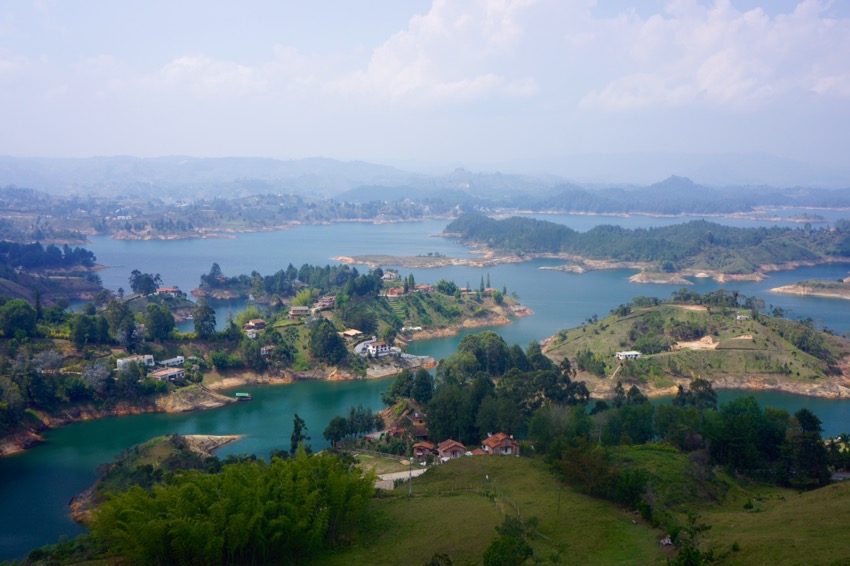
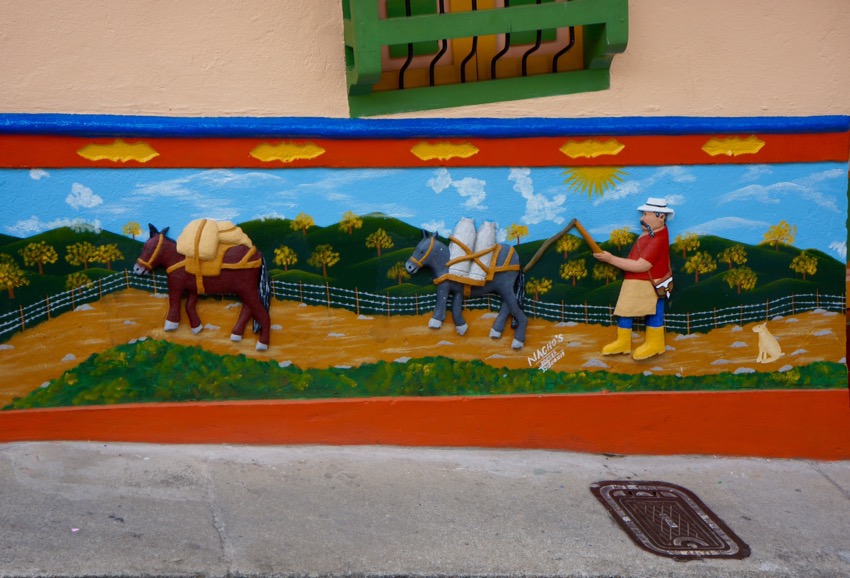
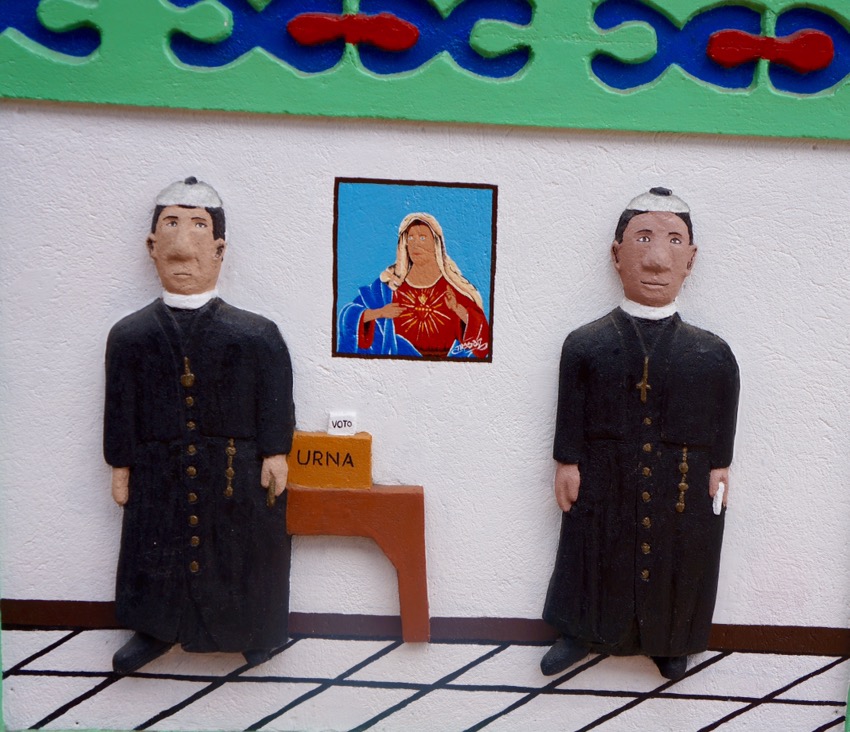 
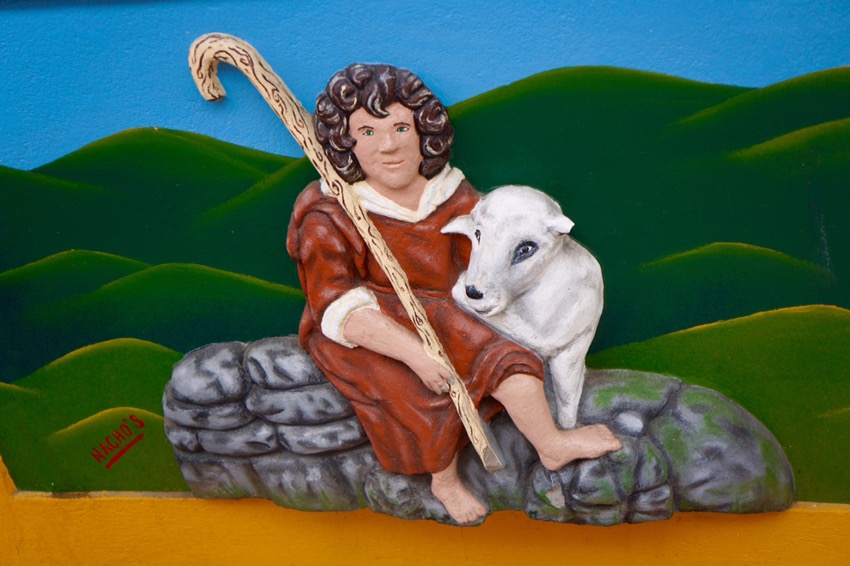 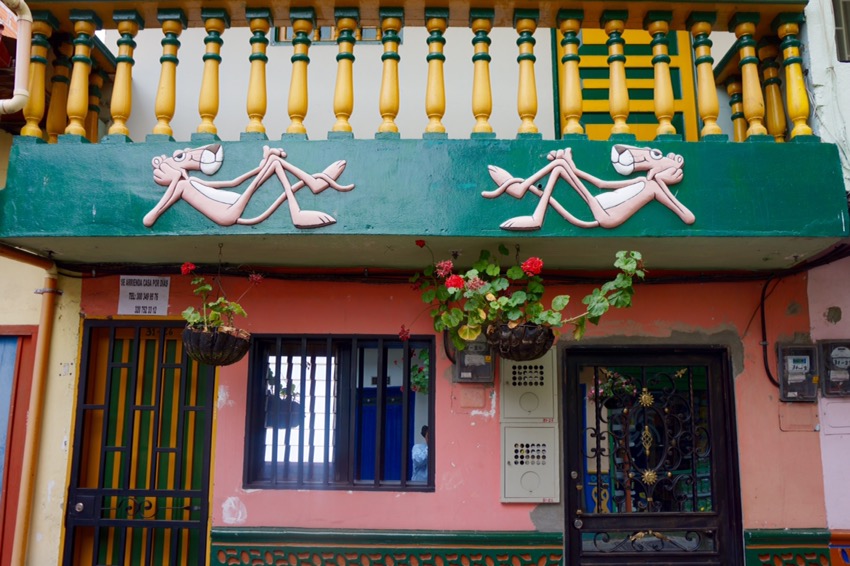
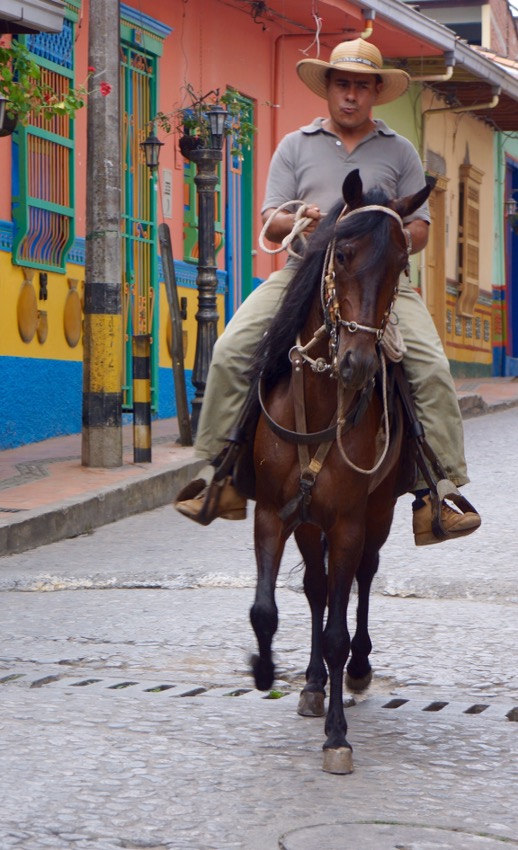
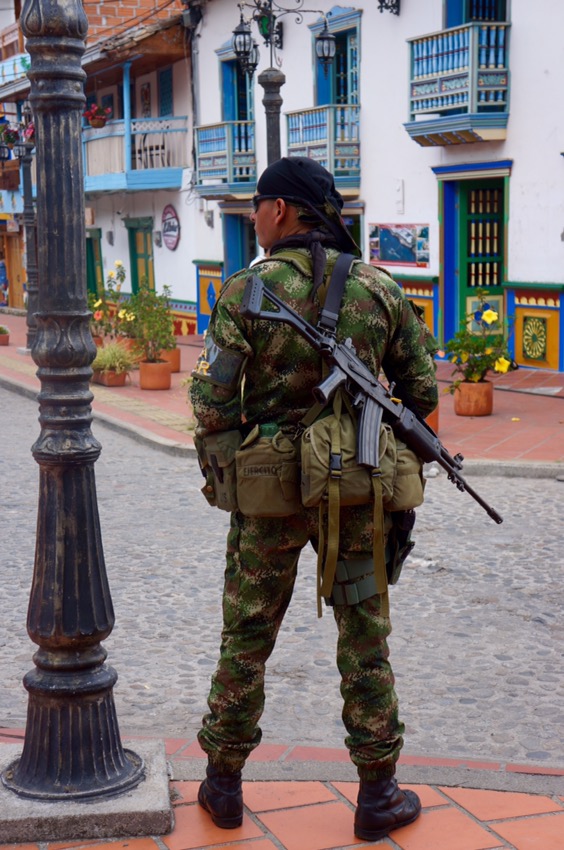 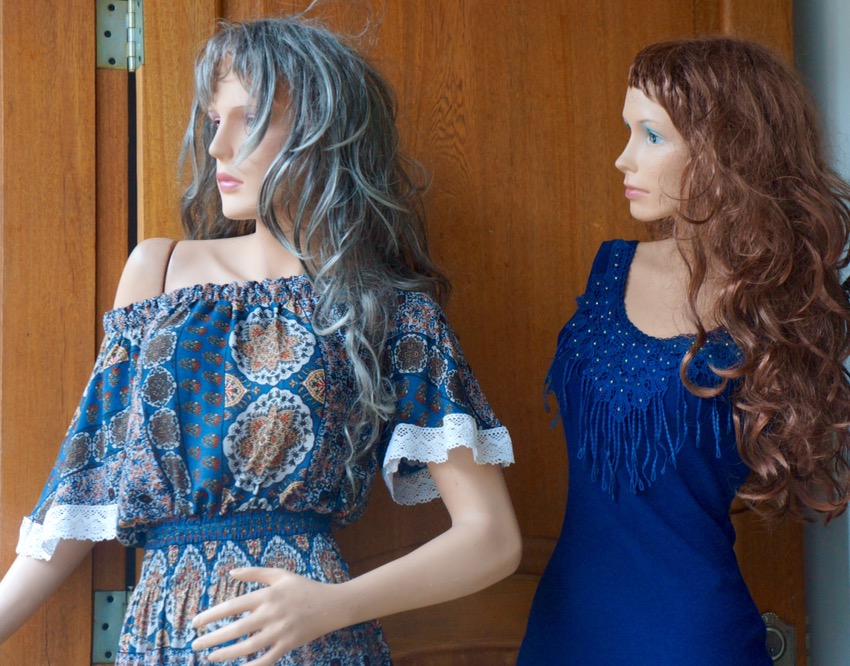
Patti Stewart and I rented a little motor taxi to scoot around town, and I got to practice my Spanish, because the driver spoke no English. Lunch at La Fogata roof by the lake–trout with too many bones.
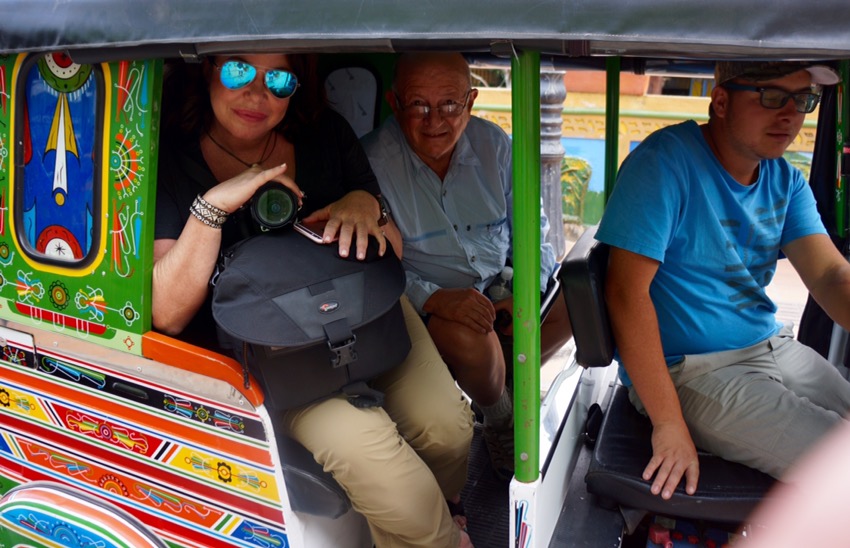
After lunch, we drove to a huge friggin’ rock, which some members of the group decided to climb (there were stairs), for reasons beyond my comprehension.

We drove back to the hotel, arriving a little after four. This gave me time to clean up, begin to pack for tomorrow’s very early departure, work on the blog and get ready for dinner with Brian Schon and his girlfriend, Laura, who picked me up at the hotel at 6:30. Brian, Laura and I had a great dinner at a truly fabulous and unusual restaurant that he chose, called El Cielo, a must splurge for anyone visiting Medellin. It was great to get to know Brian and Laura better, and to hear details about his ecotourism business and her family, home town andplans for internships and residencies.
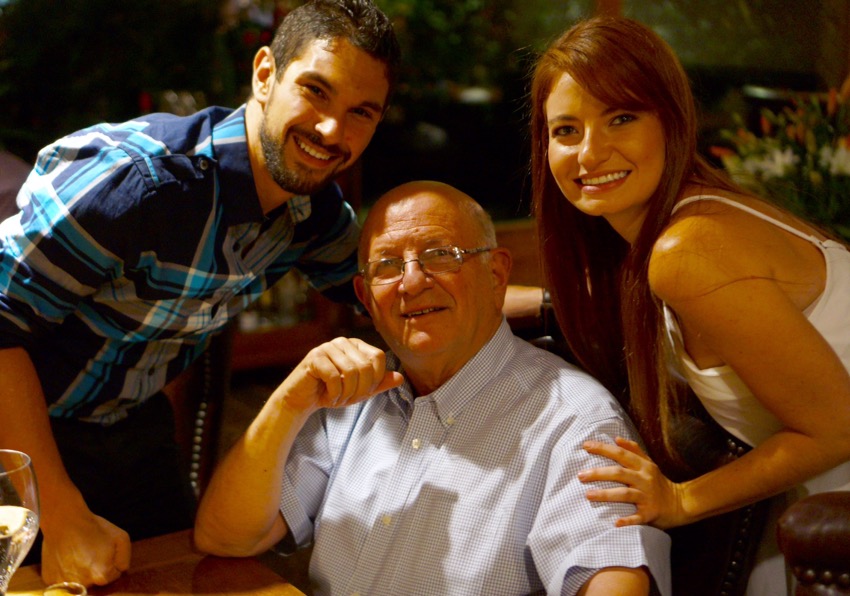 Today was a low-key, relaxed and pleasant day, which we probably need, before jumping into carnival tomorrow in Barranquilla Today was a low-key, relaxed and pleasant day, which we probably need, before jumping into carnival tomorrow in Barranquilla
February 3
Flight from Miami to Medellin was uneventful. But the arrival was not, since, as I feared, my luggage did not make it. After all, they only had seven hours to transfer it in Miami. They say it’ll be here tomorrow. The email American sent told to me, “please remain confident that you will be reunited with your property very soon. Please know that our Baggage Service Specialists are doing everything possible to reduce the amount of time you are inconvenienced.”
We’ll see. Meanwhile, the rest of the photography group may want to keep a healthy distance from me.
On the flight to Medellin, I read about a third of ALL THE LIGHT YOU CANNOT SEE, a novel that has been highly recommended to me by several people, and which had languished untouched on my iPad for several months. Very good, so far, and I hope I can keep at it on the trip. Arrived a bit after ten and, after clearing immigration (and discovering that my luggage decided not to come along, was met at the airport, along with two other people on our trip, Patti Stewart and Isabelle de Beulkaer, who arrived at about the same time as I did, and we were driven to the Hotel Park10, where we are staying. Quite a nice hotel, and a comfortable suite.
After breakfast at the hotel we had an orientation meeting with Nevada Wier, the terrific photographer with whom I’ve traveled to China, Cuba and Namibia (you can take a look at her work at www.nevadawier.com), and Adam Weintraub, a photographer based in Seattle and in Peru, who is facilitating this trip. There are eight of us on the trip, all of whom have traveled with Nevada before. We were to have been ten, but a couple needed to drop out at the last minute because of illness. Though I’m sorry for them, two fewer travelers is actually a plus for the rest of us.
Nevada and Adam had arrived in Medellin and were shown around by somebody I put them in touch with, Brian Schon. Brian is a former Segal Fellow, a program I serve on the advisory board of that was set up in memory of my good friend Eli Segal and devoted to creating citizen leaders. After serving in the Peace Corps in the Ukraine, Brian moved to Colombia where is in the process of setting up an ecotourism business. He has had great adventures already in doing this, which he delineates in his very interesting and readable blog, https://passingforpaisa.wordpress.com/. I had gotten in touch with Brian prior to the trip and was able to put him in touch with Adam, which I hope will lead to a mutually beneficial relationship between them. Brian is joining us for the day today, and I will have dinner with Brian tomorrow night.
Based on what they saw with Brian, Nevada and Adam have changed our schedule in Medellin dramatically. These sorts of changes are vintage Nevada, and are part of what makes traveling with her both interesting and fun. If you’re the type who needs rigid adherence to an itinerary, take traveling with Nevada off of your bucket list. Nevada’s photography trips are not “workshops,” that is, not expressly instructional. That said, though, traveling with Nevada and a group of avid photographers always turns out to be educational.
Colombia is very “in” in the US news. There was a large article in today’s Washington Post about the peacemaking with drug kings in Colombia http://wapo.st/20ll0Tm. And, tomorrow, President Santos, of Colombia will visit and meet with President Obama at the White House.
After the meeting, we headed out to explore Medellín ( pronounced by locals as “Medellgene”) , a city of more than four million people that has transformed itself in the past decade or so from a dangerous, drug infested city to a place that in 2014 was voted the most innovative city in the world. We began the day by heading to a barrio called LaComuna 13 in the western part of the city. It’s in an area that could be called a favela, or almost slum area in which the government has painted houses, commissioned murals and built an escalator up the mountain to give residents access to the city. At the top of the mountain a celebration was going on in which clowns performed, school supplies were given out to young families and children were given hot dogs and soft drinks.



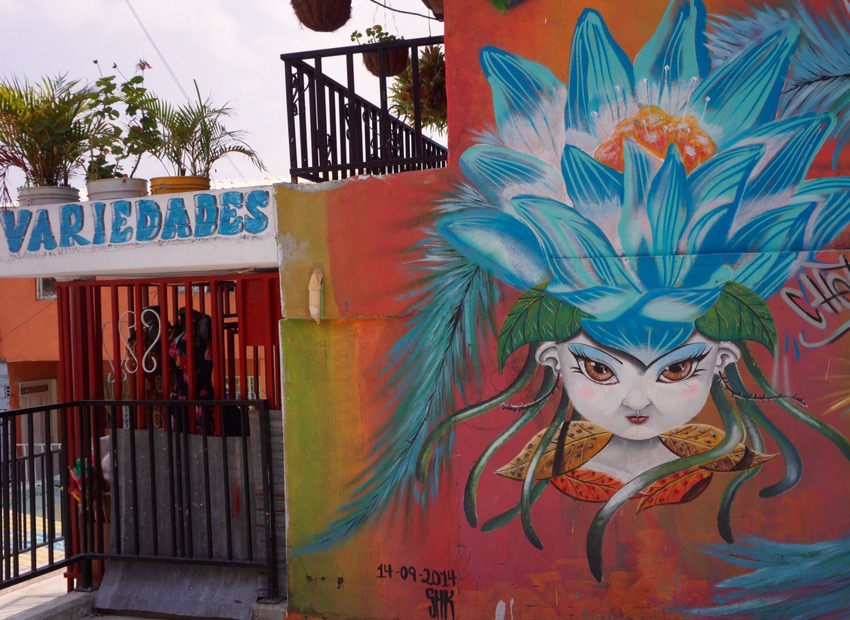
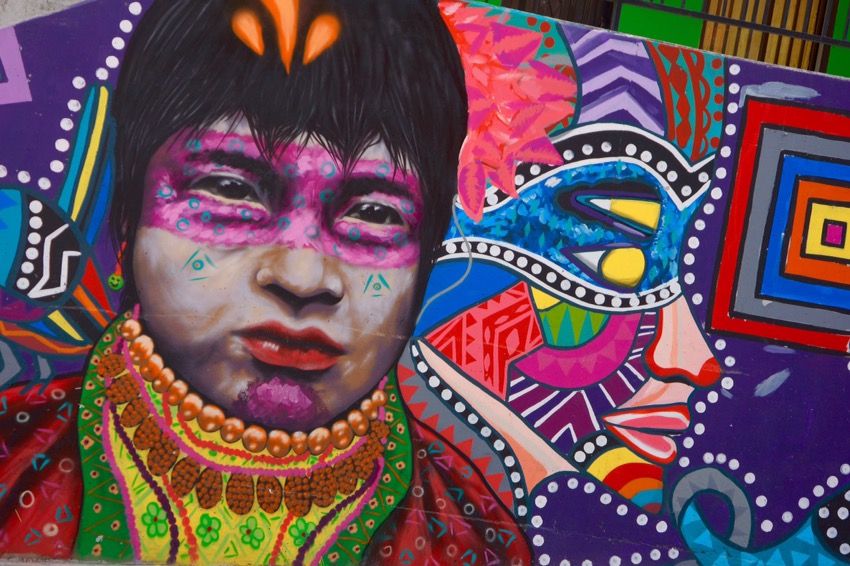
Afterward, we took a cable car ride up to the barrio of Vallejuelos, and back, giving us good views of the city and an opportunity to see the large amount of low cost housing that the government has built and the excellent transportation to and from that housing provided by the cable cars. Brian is pictured below in a cable car.
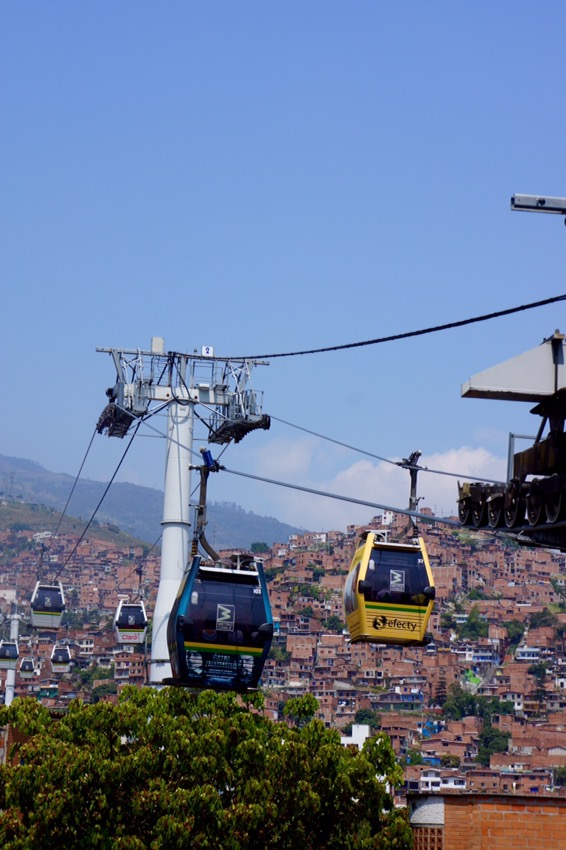

We took the modern and spotless metro to the city center, where we walked around a bit before having a traditional Colombian ¨paisa¨ lunch at La Hacienda, a popular and old restaurant in the center of the city. After lunch, we were joined by a not very inspiring (I’d say “boring,” but Nevada disagrees) local guide who told me more than I wanted to hear about things that I was not all that interested in to begin with. We went into a church, but I’ve already exceeded my lifetime limit of churches I can see on trips.
The saving grace was that it did not last long, and we made our way to the “Parque Berrio”, near the Botero sculpture park in Botero Plaza where many giant sculptures of Colombia’s most famous artist and Medellin-born sculptor Fernando Botero are exhibited. The park also teems with vendors selling watches, hats and other wares of all kinds. Nearby is a lane in which men sit at typewriters to produce letters and legal,documents. And not far away is an area where prostitutes (legal in Colombia) hang out.
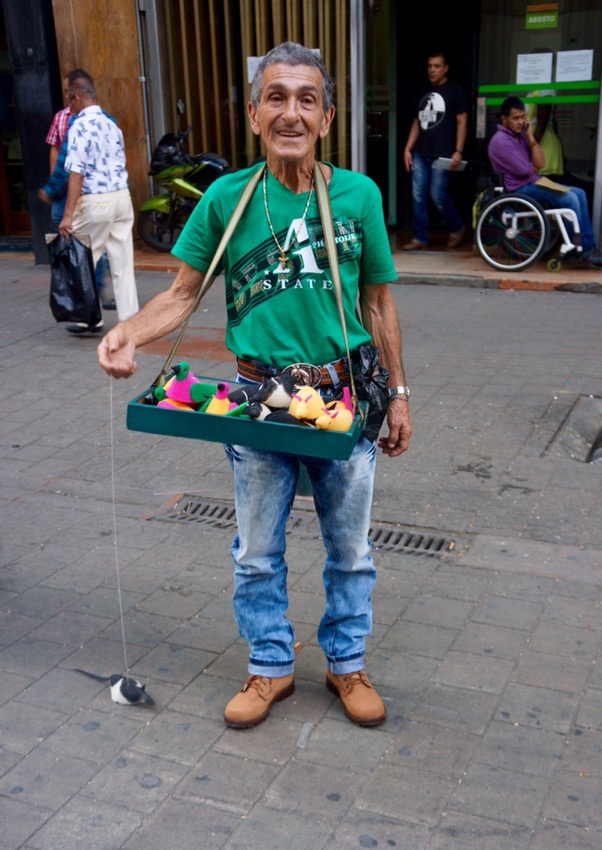
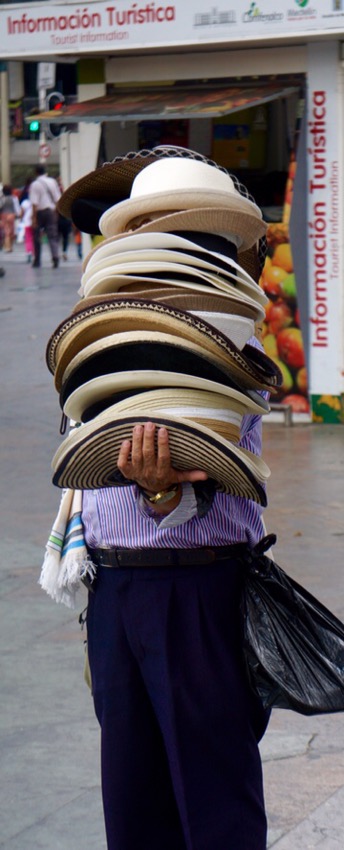 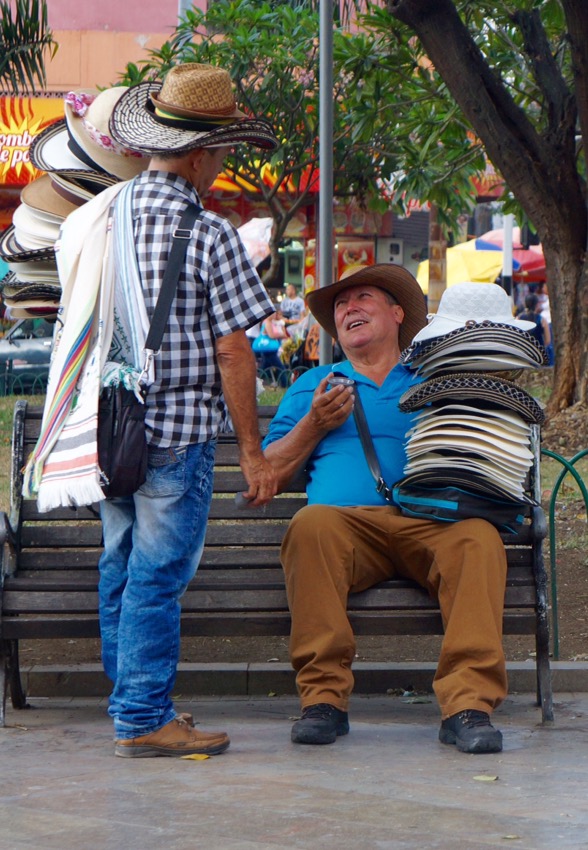
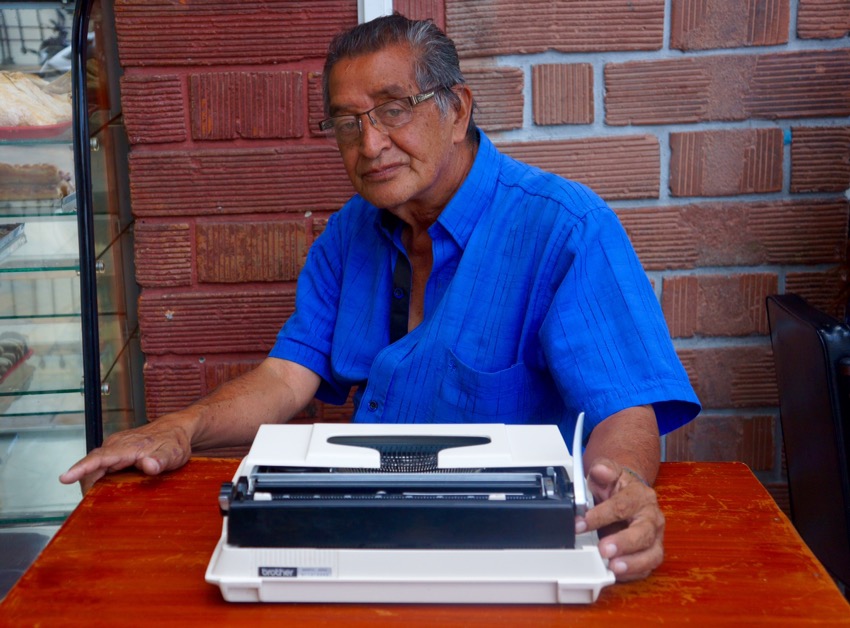 
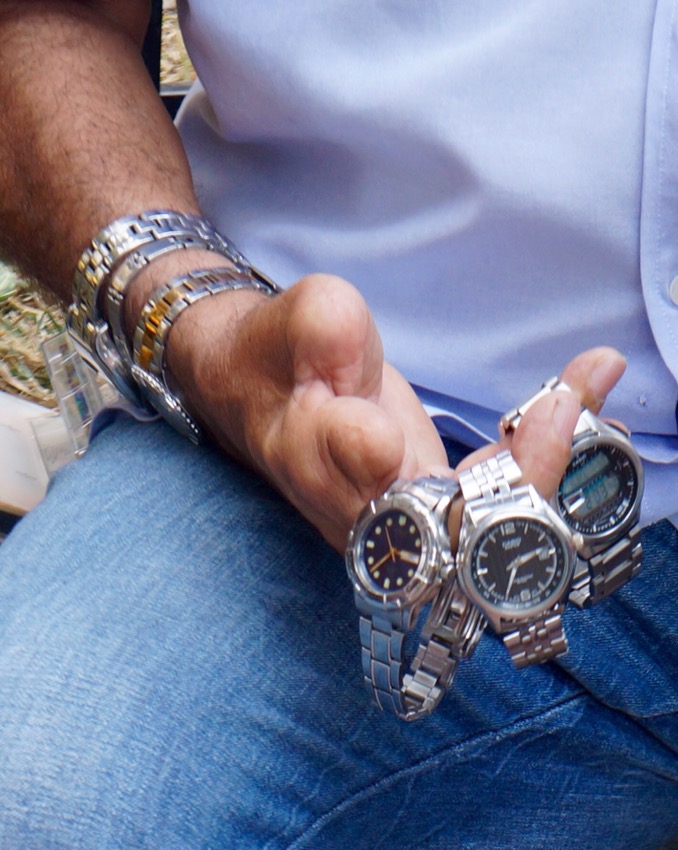 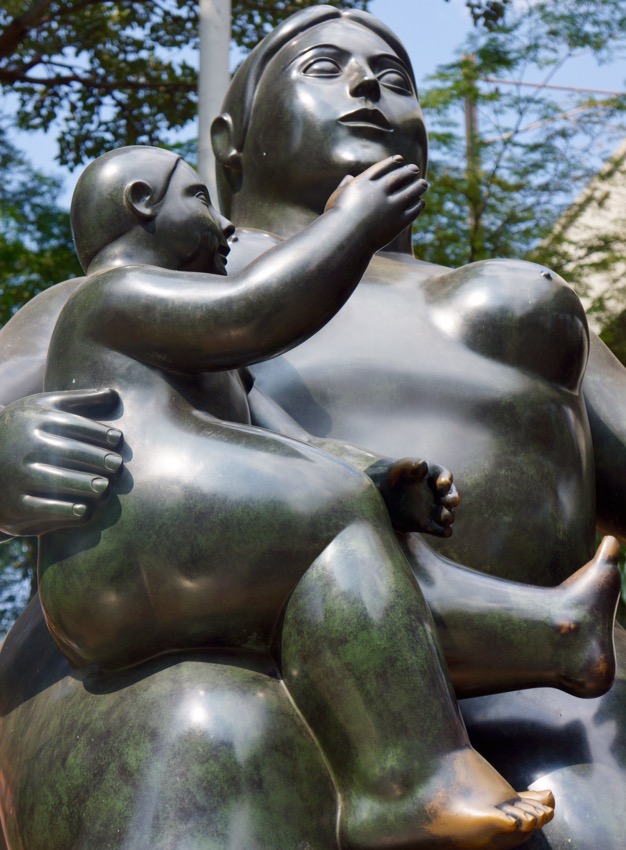
We ventured down a street known locally as “El Hueco” (the whole) full of cheap goods and fresh tropical fruits. The street is highlighted by the old Justice Department building that has been restored in paint and architecture, but turned into a low-budget shopping mall.
We passed by the buildings of the local government, the old train station, Museo de Antioquia and the Palace of Culture where office blocks share public spaces with sculptures, libraries, and the park of lights nearby, all of which we saw briefly.
Returned to the hotel, where I was happily and quite emotionally reunited with my suitcase. Ample time to shower and change, and download today’s photos (which I’d say we’re fair, at best).
We all walked about eight blocks to dinner at a very excellent restaurant called OCI. Brian and his lovely and charming girlfriend, Laura, who recently completed medical school, joined us. Walked back to the hotel, worked on the blog and retired.
For those of you who wrote to ask, or may be wondering, yes, I’ve packed plenty of bug spray to combat any Zika-carrying mosquitos. Should I encounter any, I’ll probably preserve them and have them mounted, as I don’t otherwise hunt.
February 2
In Miami now, having taken a short flight from Tampa. Good news is I was able to check my bag through to Medellin, and so won’t have to go through the hassle of claiming, rechecking and going through security at MIA, which is always a zoo. Now, whether my bag actually makes it to Medellin is a different question.
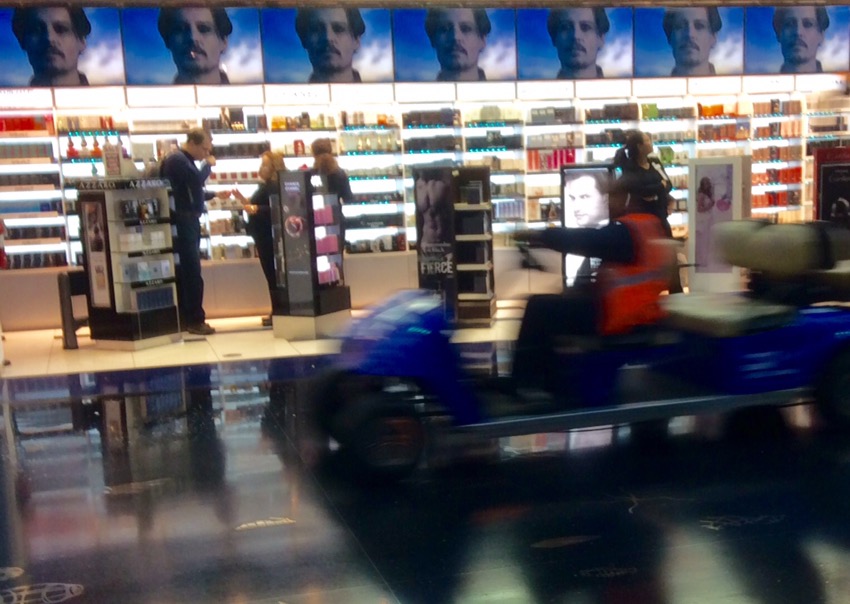
Used a free pass to get into the AA flight lounge in Miami, so I can rest in comfort for five hours. Then, I’ll fly from Miami to Medellin, Colombia, a flight of some 3 1/2 hours, arriving around 10 PM.
Traveling to South America is far easier than much of the travel I do. For one thing, it’s close, but even more importantly, there is little or no time change. That makes a huge difference at both ends of the trip.
So, here’s more than you might ever want to know about Colombia. As usual, this description is pieced together (stolen) from several websites, ranging from tourism to the CIA. It may or may not be accurate.
First a view from a tourism site. Twice the size of France, and with a diversity of landscapes and cultures that would be hard to find even in countries five times its size, Colombia should by all rights be one of the world’s top travel destinations.
Pick a climate, and it’s yours—if you find the light jacket weather of Bogotá cold, drive an hour down through the mountains and sunbathe next to the pool of your rented hacienda. If you don’t want to sit still, head off into the Amazon or any of the country’s other many inland jungles, snow-capped volcanoes, rocky deserts, endless plains, lush valleys, coffee plantations, alpine lakes, deserted beaches.
For culture, intellectual Bogotá might lead the rest of Latin America in experimental theater, indie-rock, and just sheer volume of bookstores, but you could also get a completely alien education in an Amazonian malocca, or you could delve into the huge Latin music scene of salsa and cumbia, with the most exciting dance display being the enormous Carnival of Barranquilla.
For history, wander the narrow streets of South America’s original capital in Bogotá, check out old Spanish colonial provincial retreats like Villa de Leyva, trek through the thick jungle-covered mountains of the northeast to the Lost City of the Tayrona Indians. Walk the walls of Cartagena’s achingly beautiful old city, looking over the fortified ramparts upon which the colonial history of South America pivoted.
For nightlife, hot Cali is today’s world capital of salsa, claiming that competitive distinction even over Colombia’s other vibrant big city party scenes, which keep the music going long into the small hours of the morning.
For dining, you’ll find everything from the ubiquitous cheap, delicious Colombian home-style meals to world-class upscale and modern culinary arts in the big cities, with cuisines from all corners of the world represented.
And for relaxing, there are gorgeous tropical beaches along Colombia’s Caribbean and Pacific coasts, but you can find even more laidback and peaceful retreats on the idyllic and unspoilt Caribbean island of Providencia.
The political violence has subsided substantially throughout the majority of the country and savvy travelers have already flocked here from around the world—come before everyone else catches on!
Sounds pretty good, eh? And now, for a less commercial point of view. Colombia, with a population of approximately 47 million and a size about twice that of France, is the only country in South America with coastlines on both the North Pacific Ocean and Caribbean Sea as well as the country with the world’s second most biodiversity. Lying to the south of Panama, Colombia controls the land access between Central and South America. With Panama to the north, Colombia is surrounded by Venezuela to the east, Brazil to the southeast, and Ecuador and Peru to the south west. The country was named in honor of Christopher Columbus, following the Italian version of his name (Cristoforo Colombo). Although Columbus never actually set foot on the current Colombian territory, in his fourth voyage he visited Panama, which was part of Colombia until 1903.
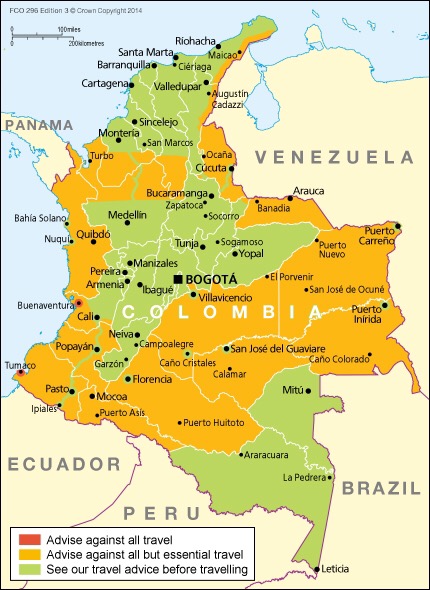
Colombia was originally inhabited by numerous,indigenous cultures like the Muisca and the Tayrona. The area that now is Colombia was colonized by the Spanish when America was ‘discovered’ by Europeans. The process of colonization radically altered the social structures of the areas and through war and disease brought by the Spanish, the indigenous populations shrank dramatically in size and their numbers dwindle since then. The Spanish brought European settlers and African slaves, while most of the population in the colony was of mixed Spanish and Indigenous ancestry.
The country became independent from Spain in 1810. It was one of the five countries liberated by Simón Bolívar (the others being Ecuador, Venezuela, Peru and Bolivia). Colombia, Ecuador, Venezuela and Panama then formed the first Republic of Colombia. Ecuador and Venezuela declared their independence from Colombia in 1830. Panama declared its independence from Colombia in 1903. The history of the country in the years to come following independence was marked by several civil wars. The legacy of these conflicts, together with troublesome social issues, early state repression against rural communities and peasants and world polarization caused by the Cold War culminated in a communist insurgent campaign by the FARC and the ELN to overthrow the Colombian Government.
A nearly five-decade-long conflict between government forces and antigovernment insurgent groups, principally the Revolutionary Armed Forces of Colombia (FARC) heavily funded by the drug trade, escalated during the 1990s. More than 31,000 former paramilitaries had demobilized by the end of 2006 and the United Self Defense Forces of Colombia as a formal organization had ceased to function. In the wake of the paramilitary demobilization, emerging criminal groups arose, whose members include some former paramilitaries. The insurgents lack the military or popular support necessary to overthrow the government, but continue attacks against civilians. Large areas of the countryside are under guerrilla influence or are contested by security forces.
In the years following 2002 the safety has been improving throughout the country. In 2012 the government and the FARC started peace talks aiming at bringing the 50 year old Civil War to an end once and for all. The Colombian Government has stepped up efforts to reassert government control throughout the country, and now has a presence in every one of its administrative departments. Despite decades of internal conflict and drug related security challenges, Colombia maintains relatively strong democratic institutions characterized by peaceful, transparent elections and the protection of civil liberties. Colombia is currently in a process of recovery, and is creating an economy thriving and attractive to many national and international investors. Ending the conflict, high income inequalities and rebuilding itself from the legacy of war are some of the issues that confront the country.
Colombia is in the midst of a demographic transition resulting from steady declines in its fertility, mortality, and population growth rates. The birth rate has fallen from more than 6 children per woman in the 1960s to just above replacement level today as a result of increased literacy, family planning services, and urbanization. However, income inequality is among the worst in the world (fertile territory for Bernie Sanders in the unlikely event that he’s not elected president), and more than a third of the population lives below the poverty line.
Colombia experiences significant legal and illegal economic emigration and refugee flows. Large-scale labor emigration dates to the 1960s; Venezuela and the United States continue to be the main host countries. Colombia is the largest source of Latin American refugees in Latin America, nearly 400,000 of whom live primarily in Venezuela and Ecuador. Forced displacement remains prevalent because of violence among guerrillas, paramilitary groups, and Colombian security forces. Afro-Colombian and indigenous populations are disproportionately affected. A leading NGO estimates that 5.2 million people have been displaced since 1985, while the Colombian Government estimates 3.6 million since 2000.
Colombia’s consistently sound economic policies and aggressive promotion of free trade agreements in recent years have bolstered its ability to weather external shocks. Real GDP has grown more than 4% per year for the past four years, continuing almost a decade of strong economic performance. All three major ratings agencies have upgraded Colombia’s government debt to investment grade, which helped to attract record levels of investment in 2013 and 2014, mostly in the hydrocarbons sector. Colombia depends heavily on energy and mining exports, making it vulnerable to a drop in commodity prices. Colombia is the world’s fourth largest coal exporter and Latin America’s fourth largest oil producer. Economic development is stymied by inadequate infrastructure, inequality, poverty, narco-trafficking and an uncertain security situation. Moreover, the unemployment rate of 9.2% in 2014 is still one of Latin America’s highest. The SANTOS Administration’s foreign policy has focused on bolstering Colombia’s commercial ties and boosting investment at home.
Colombia is an illicit producer of coca, opium poppy, and cannabis; world’s leading coca cultivator with 83,000 hectares in coca cultivation in 2011, a 17% decrease over 2010, producing a potential of 195 mt of pure cocaine; the world’s largest producer of coca derivatives; supplies cocaine to nearly all of the US market and the great majority of other international drug markets; in 2012, aerial eradication dispensed herbicide to treat over 100,549 hectares combined with manual eradication of 30,486 hectares; a significant portion of narcotics proceeds are either laundered or invested in Colombia through the black market peso exchange; important supplier of heroin to the US market; opium poppy cultivation is estimated to have fallen to 1,100 hectares in 2009 while pure heroin production declined to 2.1 mt; most Colombian heroin is destined for the US market (2013)
So, let me know if you need any heroin, put in your order as a comment to this post (just kidding, all of you federal agencies monitoring this blog). I’m going to sign off now, and meet you in Medellin. Sorry if this post bored you, but, hey, nobody told you had to read the whole damn thing. From here on, it ought to get more interesting (I hope).
Hasta luego.
You probably wonder what the hell Carol and I do between trips. Answer: we take trips. For example, between our trip to Ecuador in June and the first of October, we were with our whole family in Grand Cayman over the Fourth for the third year in a row, we went up to Milwaukee to see the Cubs play, visit the Kohler Art Center and spend time with cousins, took two granddaughters to see six shows at The Ohio Light Opera Festival in Wooster, OH and then drove to Toledo for a Toledo Mudhens baseball game, spent a long weekend of opera and friends in Santa Fe, went to DC to spend Rosh Hashanah with Jodi and family, spent a few days in New York seeing a friend receive a prestigious humanitarian award and see some plays and museums and went to Atlanta to visit Wendy and family to see Maxi turn three. Other than that, we just hung around home.
One of the shows we saw at The Ohio Light Opera Festival, Brigadoon, made me think about travel. For those who don’t know the story, two American men traveling to Scotland get lost and come upon Brigadoon, a magical place that appears, emerging from the mist, for one day every one hundred years. They are captivated by the place, it’s history (legends) and the people. One of the men almost decides not to go back to America.
Watching Brigadoon, it occurred to me that when we travel, in a way, we are always hoping to find Brigadoon, to find a place that, if not magical, will at least stretch our imaginations, introduce us to places, experiences, people and cultures that show us another way to live. On some of these trips, we may even think, “wouldn’t it be nice to live here?” But, however tempting, most of us come back.
I say most of us, because in July, we reconnected by email with somebody we’d lost touch with for many years, (I’ll call her Zora or Z, to preserve her anonymity). Zora and her husband, who I’ll call Ronaldo or R, were artists, and free spirits, “sixties people” with whom we became friendly because of their art work. Z tapestry wove distinctive, primitive figures of wool and silk. R carved wooden masks which were part of the figures. We found that these figures had a strong, spiritual quality that we Iiked and over the years, we acquired half a dozen of them and became friends of Z and R. Here is a poor photo of one of the figures.
Some 25 or more years ago, Z and R traveled to Turkey to look for for hand-spun, hand-dyed wools and silks from Bursa, each taking a backpack with them. They fell in love with Turkey, made a crash visit back to the U.S. to sell their home in Marin County and clear it of twenty years of valuables and detritus, and bought a house in Turkey, where they raised their own food and geese and donkeys, and continued to create figures. We stayed loosely in touch with them for many years, but lost contact when Ronaldo died, some years ago. Zora stayed on in Turkey and we reconnected with her by email last July through a friend of hers who she put in touch with us.
Since August, Zora and I have conducted a robust email correspondence. I’ve marveled at the different paths our lives have taken, neither one of us able to imagine living the life the other has chosen. Z continues to live in her Brigadoon, her nearest neighbor who is not very near, fortunately, as Zora has said, is a reclusive musician from Istanbul. Here’s an excerpt from one of her emails that illustrates the life she lives:
Right now we are in the middle of olive harvesting. I still have liters of our own organic olive oil left from last year but we can’t let the harvest go to waste….and friends and neighbors all still help each other so it’s a kind of Amish family feeling most days….which I love participating in…and we have more than 30 gorgeous old olive trees full of these shiny fruits…many buckets are filled everyday….then put in huge bags the size of me to be carted away to the olive presses in Milas……the big perfect ones are separated out for curing…I have seven jars going right now….adding as we go along.
At the end of olive season, an itinerant soap maker visits all the villages like ours, and each family gives him the dregs left over from the pressing to make the years olive oil soap!! Stunning work brought into the twenty-first century intact and relevant and full of cooperation ! The olive presses don’t charge money , by the way, for their services…another tradition still going today,……they take 10% of the olives, and give you the rest as oil! Time to go. Await next lively conversation!, with love
Despite our different paths, I sense that Zora, Carol and I still have a good deal in common. We’ve just made different choices.
Part of my correspondence with Zora has dealt with concepts of change, of “progress” and with things or places having been “spoiled.” Z seems to have a rather absolutist view of what is spoiled, something greater replaced by something lesser.
I wrote Zora that I thought that for most of us, what’s spoiled depends on when we first encountered it, the longer ago, the more likely that it’s spoiled. I opt for a more relativistic view of spoiled.
There are many things that others would consider progress that I do not. But that “progress” has not spoiled a thing or experience for me. And I gave Z this example:
Let me take what may seem to you like a trivial matter, but I assure you it is not. (To me, anyway; I guess trivial may be in the eye of the beholder, as well.). Wrigley Field, where the Cubs play, is a classic and beautiful old ballpark. There are pressures every year to make changes to the ballpark, the common element to each change being that it will create more revenue for the owners. This year, they’ve constructed a huge, electronic scoreboard, not markedly different than those that every other major league team has. The scoreboard is way out of proportion to, and does not fit the feel of, the rest of the park. I do not like it. At all. Before it was built I was convinced that the scoreboard would ruin (spoil) the experience of going to Wrigley Field for me, so much so that I would not go to games there.
But I was wrong. I hate the scoreboard, as I was sure I would. But the (real) grass is still green, there’s ivy on the brick walls, my favorite beer vendor still sells me beer and stops to chat, there’s a beauty and grace to the game, the crack of the bat still excites, memories of 65 years of seeing games there flood back, the crowd is a community–and I could go on. But the “progress” of a big electronic scoreboard has not spoiled the Wrigley Field experience for me.
I’ve accepted the inevitability of “progress” that is going to “spoil” things, and try to enjoy the benefits of that “progress” and the unspoiled residue. I know that for me to see an “unspoiled” area may be denying the residents of that area the benefits of being “spoiled,” and I don’t feel I have the right to expect that. In any case, I’m hoping to find a good deal of unspoiled residue in Colombia.
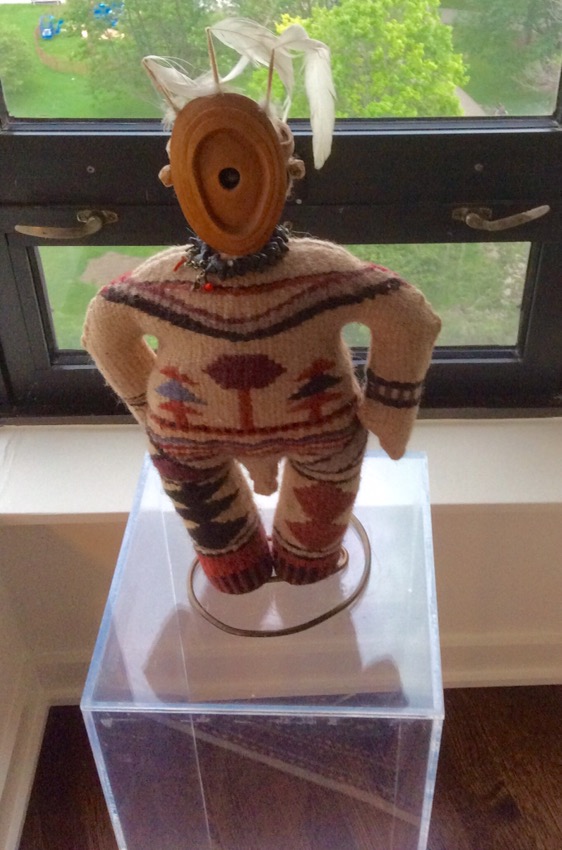
June 24
Our last day. After breakfast, Carol decides to go to a nearby Pre-Colombian art museum. I opt to sit in the lovely Casa Gangotena hotel atrium, where I’m starting this final blog entry. Diana, who showed us around Quito on our first day is to pick us up at 10:45 for our 2:05 flight to Miami, where we have a 2-hour layover before connecting for our flight to Chicago, arriving just before midnight. Our cousins, Steve and Rae Sweet, have been staying at the condo and looking after our dog, Judson, who turns one today. Happy birthday, Judson, if you’re following the blog.
Travel tips. I offer these as a reminder to myself, and because some of you may want to consider them. Pack a change of clothes in your carry-on luggage. You never think that the airlines will choose to lose your bag. But they do. Also, pack an extra small bag in your large bag. If, as was the case for us on this trip, you are coming back to one or more places you visit, taking a small bag allows you to just take the stuff you need before you return, and to check your larger bag at the hotel. I managed to do that for one leg of our trip, but Carol did not.
Reflections on the trip. Considering that we experienced lost luggage, landslides, bouts of no electricity or hot water, pouring rain and chill for days, thin air, muddy and slippery trails, bumpy roads and a collection of bugs, beetles and spiders in one of our rooms, it was a helluva trip. In retrospect, those all seem like character-building blips on a delightful 8 days.
Best part was taking this trip alone with Carol. It was a sort of reprise of the fabulous 11-week honeymoon trip we took fifty years ago to Europe, Greece and Israel. Of course, we traveled at a luxury level on this trip that we did not as 22-year olds, when we pretty-much traveled on $5 a day. Were we to do a trip similar to our honeymoon today, we would be traveling in a way that would make for a totally different experience. Both youth and senior status have their benefits.
We went to see the birds. And the birds were great. But it won’t be the birds we remember most about this trip. We met some amazing people.
Our 22-year old guide, Josue, was mature, knowledgeable and wise way beyond his age. He was an ideal guide and companion in every way, from identifying and explaining everything we encountered to handling and catering to all of our needs to finding a deck of cards and playing with us, when rain prevented outdoor activity. We hope to stay in touch with Josue, and perhaps even to help with his career.
Along the way, we met local people who were committed to preserving and helping others to enjoy Ecuador’s unique environment. Alejandro, Angel and Mercedes were all unforgettable characters, even though we were able to spend only very limited time with them.
Fellow travelers, Allen and Carol from California and Luis and Sylvia from Barcelona, were fun to share experiences with. It’s possible our paths may cross again. Susi and Franklin, with whom we had dinner in Quito, were personable and fun. Our paths will certainly cross again, because of their daughter and son in law in Chicago. Finally, Diana, who showed us around Quito and drove us from and to the airport, was quite delightful.
Two things about Quito stand out. The amazing Casa Gangotena where we stayed, one of our top couple hotel experiences anywhere, including both the facility and the service. And the Chapel of Man that houses the work of painter, Guayasamin, which blew us away.
The birding was interesting and fun. Neither Carol nor I is likely to become the type of avid birder we encountered on the trip. But I definitely can see us doing more of it. Carol is more into identifying the particular species we see, and I’m more interested in recording the experience with my camera. I’m very happy with the decision I made to get a new and relatively inexpensive camera to allow me to photograph birds on this trip,
The kind of birding we did on this trip was easy birding, much of it involving seeing species that had been attracted to the area through feeding, and relatively little of it involving finding the species along trails. While “real” birders might consider what we did cheating, I don’t fully buy that. These birds were not captive; they were in the wild, but attracted by food.
I suppose it depends on whether your emphasis is on finding the birds, or seeing them. If it’s the latter, what we did certainly fits the bill. Fact is, we would have done more of tracking birds in the wild except for several factors–the cold and rainy weather on some days, the muddy and slippery conditions, and the physical ability necessary to do some of the trails (which was made more difficult by the altitude). I’m also suffering from two disabilities. For more than a month, I’ve had planters something-itis that causes pain in the heel and makes walking painful and difficult. Perhaps more serious, I’ve been suffering from fatness, a self-inflicted condition caused by love of the wrong foods and drink.
Birding seems a bit like golf for me. I can enjoy it, as long as I don’t get hung up on needing to be really good at it. It’s something that takes you to lovely places in which you can enjoy the landscape and just being outdoors. And it’s an activity you can continue as you get (or have gotten) older. It’s also a social activity that you can enjoy with people at different levels of interest and experience. One nice thing, to me, about where we are in birding is that we are at such a preliminary stage that almost everything is new, and we are almost sure to improve.
There’s also a certain spiritual aspect to birding. As our friend, Susie Kiphart, wrote in a comment to the blog, “I cannot possibly get why these birds would be this varied and beautiful if the Great Weaver God did not create it all this way –and of course want us to love the earth and have “dominion” —take good care of it. I have heard it said that if we do not grow to notice and love it then we can’t have the motivation to take care of it. Thanks for helping us notice!!!” Personally, I don’t think you need to reach this conclusion through belief in a God, though I certainly see how that might fit. Seeing these birds and the beautiful landscape in which they reside gives one the feeling of something larger than yourself. And for those of us who have children and, perhaps especially grandchildren, it evokes a feeling of wanting to preserve this for them and their progeny. It’s not ours to use up. I’m thinking that maybe I should run for Pope. Whaddayathink, should we start an Arnie for Pope PAC?
I’m writing this aloft from Quito to Miami, grateful once again for the good fortune that has allowed me to travel like this. Thanks for following, and for your comments. While Carol and I have many trips planned, those in the short term are not the bloggable type (for me, any way). Next time I see you in the blogosphere will be in Colombia next February, where I’ll be going (without Carol) on a photography trip. Hasta luego.
|
|
 Today was a low-key, relaxed and pleasant day, which we probably need, before jumping into carnival tomorrow in Barranquilla
Today was a low-key, relaxed and pleasant day, which we probably need, before jumping into carnival tomorrow in Barranquilla





























